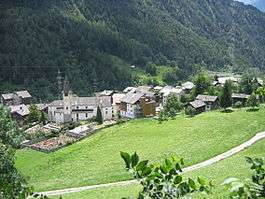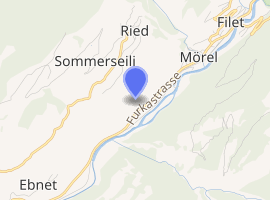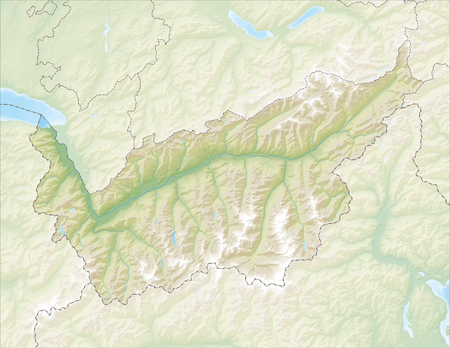Mörel, Switzerland
Mörel is a former municipality in the district of Raron in the canton of Valais in Switzerland. In 2009 Mörel merged with Filet into the municipality of Mörel-Filet.[1]
Mörel | |
|---|---|
 | |
Location of Mörel 
| |
 Mörel  Mörel | |
| Coordinates: 46°21′N 8°2′E | |
| Country | Switzerland |
| Canton | Valais |
| District | Raron |
| Area | |
| • Total | 1.2 km2 (0.5 sq mi) |
| Elevation | 746 m (2,448 ft) |
| Population (December 2008) | |
| • Total | 450 |
| • Density | 380/km2 (970/sq mi) |
| Postal code | 3983 |
| SFOS number | 6179 |
| Surrounded by | Filet, Riederalp, Termen |
| Website | www SFSO statistics |
History
Mörel is first mentioned in 1203 as Morgi.[2]
Geography
Mörel was the capital of the Östlich Raron district until the merger into Mörel-Filet. It is located in a small bend on the right bank of the Rhone river.
Coat of arms
The blazon of the village coat of arms is Gules, an Ox head guardant Sable holding two Ears of grain Or in mouth.[3]
Demographics
Mörel has a population (as of December 2008) of 450.[4]
Most of the population (as of 2000) speaks German (500 or 95.4%) as their first language, Serbo-Croatian is the second most common (7 or 1.3%) and French is the third (3 or 0.6%). There is 1 person who speaks Italian.[5]
As of 2008, the population was made up of 450 Swiss citizens and 52 non-citizen residents (10.36% of the population).[4] Of the population in the village, 187 or about 35.7% were born in Mörel and lived there in 2000. There were 208 or 39.7% who were born in the same canton, while 56 or 10.7% were born somewhere else in Switzerland, and 57 or 10.9% were born outside of Switzerland.[5]
As of 2000, there were 193 people who were single and never married in the village. There were 273 married individuals, 34 widows or widowers and 24 individuals who are divorced.[5]
There were 73 households that consist of only one person and 14 households with five or more people. In 2000, a total of 215 apartments (51.2% of the total) were permanently occupied, while 175 apartments (41.7%) were seasonally occupied and 30 apartments (7.1%) were empty.[6]
The historical population is given in the following chart:[2][7]

Politics
In the 2007 federal election the most popular party was the CVP which received 53.02% of the vote. The next three most popular parties were the FDP (18.13%), the SVP (15.05%) and the SP (11.82%). In the federal election, a total of 288 votes were cast, and the voter turnout was 71.6%.[8]
Economy
There were 242 residents of the village who were employed in some capacity, of which females made up 40.1% of the workforce.
In 2008 the total number of full-time equivalent jobs was 247. The number of jobs in the primary sector was 5, all of which were in agriculture. The number of jobs in the secondary sector was 44 of which 2 or (4.5%) were in manufacturing and 38 (86.4%) were in construction. The number of jobs in the tertiary sector was 198. In the tertiary sector; 24 or 12.1% were in the sale or repair of motor vehicles, 72 or 36.4% were in the movement and storage of goods, 46 or 23.2% were in a hotel or restaurant, 2 or 1.0% were the insurance or financial industry, 4 or 2.0% were technical professionals or scientists, 19 or 9.6% were in education and 21 or 10.6% were in health care.[9]
In 2000, there were 163 workers who commuted into the village and 139 workers who commuted away. The village is a net importer of workers, with about 1.2 workers entering the village for every one leaving. About 3.7% of the workforce coming into Mörel are coming from outside Switzerland.[10]
Religion
From the 2000 census, 443 or 84.5% were Roman Catholic, while 24 or 4.6% belonged to the Swiss Reformed Church. Of the rest of the population, there were 5 members of an Orthodox church (or about 0.95% of the population), there were 2 individuals (or about 0.38% of the population) who belonged to the Christian Catholic Church, and there were 6 individuals (or about 1.15% of the population) who belonged to another Christian church. There were 10 (or about 1.91% of the population) who were Islamic. 14 (or about 2.67% of the population) belonged to no church, are agnostic or atheist, and 23 individuals (or about 4.39% of the population) did not answer the question.[5]
Education
In Mörel about 188 or (35.9%) of the population have completed non-mandatory upper secondary education, and 50 or (9.5%) have completed additional higher education (either university or a Fachhochschule). Of the 50 who completed tertiary schooling, 70.0% were Swiss men, 18.0% were Swiss women.[5]
During the 2010-2011 school year there were a total of 164 students in the Mörel school system. The education system in the Canton of Valais allows young children to attend one year of non-obligatory Kindergarten.[11] During that school year, there was one kindergarten class (KG1 or KG2) and 15 kindergarten students. The canton's school system requires students to attend six years of primary school. In Mörel there were a total of 4 classes and 64 students in the primary school. The secondary school program consists of three lower, obligatory years of schooling (orientation classes), followed by three to five years of optional, advanced schools. There were 100 lower secondary students who attended school in Mörel.[12] All the upper secondary students attended school in another municipality.
As of 2000, there were 60 students in Mörel who came from another village, while 41 residents attended schools outside the village.[10]
Mörel is home to the Regionalbibliothek library. It was open a total of 121 days with average of 6 hours per week during that year.[13]
References
- Amtliches Gemeindeverzeichnis der Schweiz published by the Swiss Federal Statistical Office (in German) accessed 19 July 2011
- Mörel in German, French and Italian in the online Historical Dictionary of Switzerland.
- Flags of the World.com accessed 4 October 2011
- Swiss Federal Statistical Office - Superweb database - Gemeinde Statistics 1981-2008 (in German) accessed 19 June 2010
- STAT-TAB Datenwürfel für Thema 40.3 - 2000 Archived 9 August 2013 at the Wayback Machine (in German) accessed 2 February 2011
- Swiss Federal Statistical Office STAT-TAB - Datenwürfel für Thema 09.2 - Gebäude und Wohnungen Archived 7 September 2014 at the Wayback Machine (in German) accessed 28 January 2011
- Swiss Federal Statistical Office STAT-TAB Bevölkerungsentwicklung nach Region, 1850-2000 Archived 30 September 2014 at the Wayback Machine (in German) accessed 29 January 2011
- Swiss Federal Statistical Office, Nationalratswahlen 2007: Stärke der Parteien und Wahlbeteiligung, nach Gemeinden/Bezirk/Canton (in German) accessed 28 May 2010
- Swiss Federal Statistical Office STAT-TAB Betriebszählung: Arbeitsstätten nach Gemeinde und NOGA 2008 (Abschnitte), Sektoren 1-3 Archived 25 December 2014 at the Wayback Machine (in German) accessed 28 January 2011
- Swiss Federal Statistical Office - Statweb Archived 4 August 2012 at Archive.today (in German) accessed 24 June 2010
- EDK/CDIP/IDES (2010). Kantonale Schulstrukturen in der Schweiz und im Fürstentum Liechtenstein / Structures Scolaires Cantonales en Suisse et Dans la Principauté du Liechtenstein (PDF) (Report). Retrieved 24 June 2010.
- Obligatorische Schulzeit (in German) accessed 24 August 2011
- Swiss Federal Statistical Office, list of libraries (in German) accessed 14 May 2010
External links
- Official website (in German)